Propeller Effects and Elasticity in Aerodynamic Analysis of Small Propeller-Driven Aircraft and UAVs
Abstract
:1. Introduction
2. Materials and Methods
2.1. Rigid Aircraft Aerodynamic Analysis with Propeller Effects
Rigid Aircraft Analysis Validation
2.2. Elastic Wing Integration
3. Results
3.1. Rigid Aircraft Aerodynamic Analysis
3.2. Aircraft Aerodynamic Analysis with Elastic Wing Integration
4. Conclusions
Funding
Data Availability Statement
Conflicts of Interest
References
- Garrow, L.A.; German, B.; Schwab, N.T.; Patterson, M.D.; Mendonca, N.; Gawdiak, Y.O.; Murphy, J.R. A Proposed Taxonomy for Advanced Air Mobility. In Proceedings of the AIAA AVIATION 2022 Forum 2022, Chicago, IL, USA, 27 June–1 July 2022; p. 3321. [Google Scholar] [CrossRef]
- Du, S.; Zha, Y.; Zhao, Q. Research on Aerodynamic Test Validation and the Vector Force Control Method for an E-STOL Fan Wing Unmanned Aerial Vehicle. Aerospace 2024, 11, 55. [Google Scholar] [CrossRef]
- Wen, J.; Song, Y.; Wang, H.; Han, D.; Yang, C. Training Sample Pattern Optimization Based on a Swarm Intelligence Algorithm for Tiltrotor Flight Dynamics Model Approximation. Aerospace 2023, 10, 1006. [Google Scholar] [CrossRef]
- NASA Website, Advanced Air Mobility Mission Overview. Available online: https://www.nasa.gov/aam (accessed on 12 February 2024).
- Transport Canada, Advanced Air Mobility. Available online: https://tc.canada.ca/en/aviation/advanced-air-mobility (accessed on 12 February 2024).
- FAA Website, Section 6. Advanced Air Mobility. Available online: https://www.faa.gov/air_traffic/publications/atpubs/aim_html/chap11_section_6.html (accessed on 12 February 2024).
- Kiesewetter, L.; Shakib, K.H.; Singh, P.; Rahman, M.; Khandelwal, B.; Kumar, S.; Shah, K. A holistic review of the current state of research on aircraft design concepts and consideration for advanced air mobility applications. Prog. Aerosp. Sci. 2023, 142, 100949. [Google Scholar] [CrossRef]
- Rostami, M.; Chung, J.; Neufeld, D. Vertical tail sizing of propeller-driven aircraft considering the asymmetric blade effect. Proc. Inst. Mech. Eng. Part G J. Aerosp. Eng. 2021, 236, 1184–1195. [Google Scholar] [CrossRef]
- Benedict, M.; Jarugumilli, T.; Chopra, I. Effect of rotor geometry and blade kinematics on cycloidal rotor hover performance. J. Aircr. 2013, 50, 1340–1352. [Google Scholar] [CrossRef]
- Rostami, M.; Bagherzadeh, S.A. Development and validation of an enhanced semi-empirical method for estimation of aerodynamic characteristics of light, propeller-driven airplanes. Proc. Inst. Mech. Eng. Part G J. Aerosp. Eng. 2018, 232, 638–648. [Google Scholar] [CrossRef]
- Cole, J.A.; Maughmer, M.D.; Kinzel, M.; Bramesfeld, G. Higher-order free-wake method for propeller-wing systems. J. Aircr. 2019, 56, 150–165. [Google Scholar] [CrossRef]
- Rostami, M.; Chung, J.; Park, H.U. Design optimization of multi-objective proportional–Integral–Derivative controllers for enhanced handling quality of a twin-engine, propeller-driven airplane. Adv. Mech. Eng. 2020, 12, 1687814020923178. [Google Scholar] [CrossRef]
- Clarke, M.A.; Erhard, R.M.; Alonso, J.J. Aerodynamic Optimization of Wing-Mounted Propeller Configurations for Distributed Electric Propulsion Architectures, AIAA Aviat. Aeronaut. In Proceedings of the Forum Expo. AIAA Aviation Forum 2021, Virtual Event, 2–6 August 2021; pp. 1–19. [Google Scholar] [CrossRef]
- Rostami, M.; Chung, J. Multidisciplinary Analysis Program for Light Aircraft (Mapla). Prog. Can. Mech. Eng. 2021, 4, 27–30. [Google Scholar] [CrossRef]
- Rostami, M.; Bardin, J.; Neufeld, D.; Chung, J. EVTOL Tilt-Wing Aircraft Design under Uncertainty Using a Multidisciplinary Possibilistic Approach. Aerospace 2023, 10, 718. [Google Scholar] [CrossRef]
- Rostami, M.; Bardin, J.; Neufeld, D.; Chung, J. A Multidisciplinary Possibilistic Approach to Size the Empennage of Multi-Engine Propeller-Driven Light Aircraft. Aerospace 2022, 9, 160. [Google Scholar] [CrossRef]
- Oyama, Y.; Rostami, M.; Chung, J. Conceptual Design and Analysis of a Box Fan-in-Split-Wing Tiltrotor EVTOL Aircraft. Aircr. Eng. Aerosp. Technol. 2024. [Google Scholar] [CrossRef]
- Liu, Y.; Druyor, C.T.; Wang, L. High-fidelity Analysis of Lift+Cruise VTOL Urban Air Mobility Concept Aircraft. In Proceedings of the AIAA AVIATION 2023 Forum, San Diego, CA, USA, 12–16 June 2023; p. 3671. [Google Scholar] [CrossRef]
- Liu, Y.; Wang, L. High-Fidelity Simulations of Lift+Cruise VTOL Urban Air Mobility Concept Aircraft in Hover. In Proceedings of the AIAA SciTech Forum Exposition 2024, Orlando, FL, USA, 8–12 January 2024; pp. 1–21. [Google Scholar] [CrossRef]
- Diaz, P.V.; Yoon, S. Computational Analysis of Urban Air Mobility Vehicles. In Proceedings of the 8th European Conference for Aeronautics and Space Sciences, Madrid, Spain, 1–4 July 2019. [Google Scholar] [CrossRef]
- Murphy, P.C.; Buning, P.G.; Simmons, B.M. Rapid aero modeling for urban air mobility aircraft in computational experiments. In Proceedings of the AIAA Scitech 2021 Forum, Virtual, 11–15 January 2021; pp. 1–23. [Google Scholar] [CrossRef]
- Yoon, S.; Lee, H.C.; Pulliam, T.H. Computational Analysis of Multi-Rotor Flows. In Proceedings of the 54th AIAA Aerospace Sciences Meeting, San Diego, CA, USA, 4–8 January 2016. [Google Scholar] [CrossRef]
- Kenway, G.K.W.; Martins, J.R.R.A. Multipoint high-fidelity aerostructural optimization of a transport aircraft configuration. J. Aircr. 2014, 51, 144–160. [Google Scholar] [CrossRef]
- Andersen, G.R.; Cowan, D.L.; Piatak, D.J. Aeroelastic modeling, analysis and testing of a morphing wing structure. In Proceedings of the 48th AIAA/ASME/ASCE/AHS/ASC Structures, Structural Dynamics, and Materials Conference, Honolulu, HI, USA, 23–26 April 2007; Volume 1, pp. 359–373. [Google Scholar] [CrossRef]
- Tiomkin, S.; Raveh, D.E. A review of membrane-wing aeroelasticity. Prog. Aerosp. Sci. 2021, 126, 100738. [Google Scholar] [CrossRef]
- Geuzaine, P.; Brown, G.; Harris, C.; Farhat, C. Aeroelastic dynamic analysis of a full F-16 configuration for various flight conditions. AIAA J. 2003, 41, 363–371. [Google Scholar] [CrossRef]
- Taylor, N.V.; Allen, C.B.; Gaitonde, A.; Jones, D.P. A structure-coupled CFD method for time-marching flutter analysis. Aeronaut. J. 2004, 108, 389–401. [Google Scholar] [CrossRef]
- Woodgate, M.A.; Badcock, K.J.; Rampurawala, A.M.; Richards, B.E.; Nardini, D.; DeC Henshaw, M.J. Aeroelastic calculations for the hawk aircraft using the euler equations. J. Aircr. 2005, 42, 1005–1012. [Google Scholar] [CrossRef]
- NASA STRuctrual ANalysis (NASTRAN). Available online: https://software.nasa.gov/software/LAR-16804-GS#:~:text=NASTRAN%20is%20a%20finite%20element,for%20insight%20into%20structural%20behavior (accessed on 12 February 2024).
- Kilimtzidis, S.; Kostopoulos, V. Static Aeroelastic Optimization of High-Aspect-Ratio Composite Aircraft Wings via Surrogate Modeling. Aerospace 2023, 10, 251. [Google Scholar] [CrossRef]
- MSC Nastran 2017—Aeroelastic Analysis User’s Guide. 2017. Available online: https://simcompanion.hexagon.com/customers/s/article/msc-nastran-2017-1--aeroelastic-analysis-user-s-guide-doc11552 (accessed on 12 February 2024).
- Solano, D.; Sarojini, D.; Corman, J.; Mavris, D. Structural sizing of unconventional aircraft under static and dynamic aeroelastic loading. In Proceedings of the AIAA Scitech 2020 Forum, Orlando, FL, USA, 6–10 January 2020. 1 PartF. [Google Scholar] [CrossRef]
- Guo, H.; Yan, Y.; Xia, H.; Yu, L.; Lv, B. The Prediction and Correction Method of Aircraft Static Aeroelastic Effects: A Review of Recent Progress. Actuators 2022, 11, 309. [Google Scholar] [CrossRef]
- Guerrero, J.E.; Sanguineti, M.; Wittkowski, K. Variable cant angle winglets for improvement of aircraft flight performance. Meccanica 2020, 55, 1917–1947. [Google Scholar] [CrossRef]
- Hoang, N.T.B. Computational investigation of variation in wing aerodynamic load under effect of aeroelastic deformations. J. Mech. Sci. Technol. 2018, 32, 4665–4673. [Google Scholar] [CrossRef]
- Scholten, W.; Hartl, D. Uncoupled method for static aeroelastic analysis. J. Fluids Struct. 2021, 101, 103221. [Google Scholar] [CrossRef]
- Guo, S. Aeroelastic optimization of an aerobatic aircraft wing structure. Aerosp. Sci. Technol. 2007, 11, 396–404. [Google Scholar] [CrossRef]
- Amoozgar, M.R.; Fazelzadeh, S.A.; Khodaparast, H.H.; Friswell, M.I.; Cooper, J.E. Aeroelastic stability analysis of aircraft wings with initial curvature. Aerosp. Sci. Technol. 2020, 107, 106241. [Google Scholar] [CrossRef]
- Crovato, A.; Almeida, H.S.; Vio, G.; Silva, G.H.; Prado, A.P.; Breviglieri, C.; Guner, H.; Cabral, P.H.; Boman, R.; Terrapon, V.E.; et al. Effect of levels of fidelity on steady aerodynamic and static aeroelastic computations. Aerospace 2020, 7, 42. [Google Scholar] [CrossRef]
- Wolowicz, H.; Yancey, R.B. Longitudinal Aerodynamic Characteristics of Light, Twin-Engine Propeller-Driven Airplanes. In Nasa Technical Note; No. H-646; NASA Flight Research Center: Edwards, CA, USA, 1972. [Google Scholar]
- Wolowicz, H.; Yancey, R.B. Lateral Directional Aerodynamic Characteristics of Light, Twin-Engine Propeller-Driven Airplanes. In Nasa Technical Note; No. H-694; NASA Flight Research Center: Edwards, CA, USA, 1972; pp. 17–56. [Google Scholar]
- Rodden, W.P.; Revell, J.D. Errata: “The Status of Unsteady Aerodynamic Influence Coefficients”. AIAA J. 1963, 1, 724–725. [Google Scholar] [CrossRef]
- Giesing, J.P.; Kalman, T.P.; Rodden, W.P. Correction Factor Techniques for Improving Aerodynamic Prediction Methods, NASA Rep. 1976. Available online: https://ntrs.nasa.gov/citations/19760016071 (accessed on 12 February 2024).
- Morlier, J. “Wing Creation using PCL/PATRAN”, DMSM/ISAE, SUPAERO. 2011. Available online: https://docplayer.net/12545262-Wing-creation-using-pcl-patran.html (accessed on 12 February 2024).
- Rodden, W.P.; Wilson, C.T.; Herting, D.N.; Bellinger, E.D.; MacNeal, R.H. Static Aeroelastic Addition to MSC/NASTRAN; The MacNeal-Schwendler Corporation: Los Angeles, CA, USA, 1984. [Google Scholar]
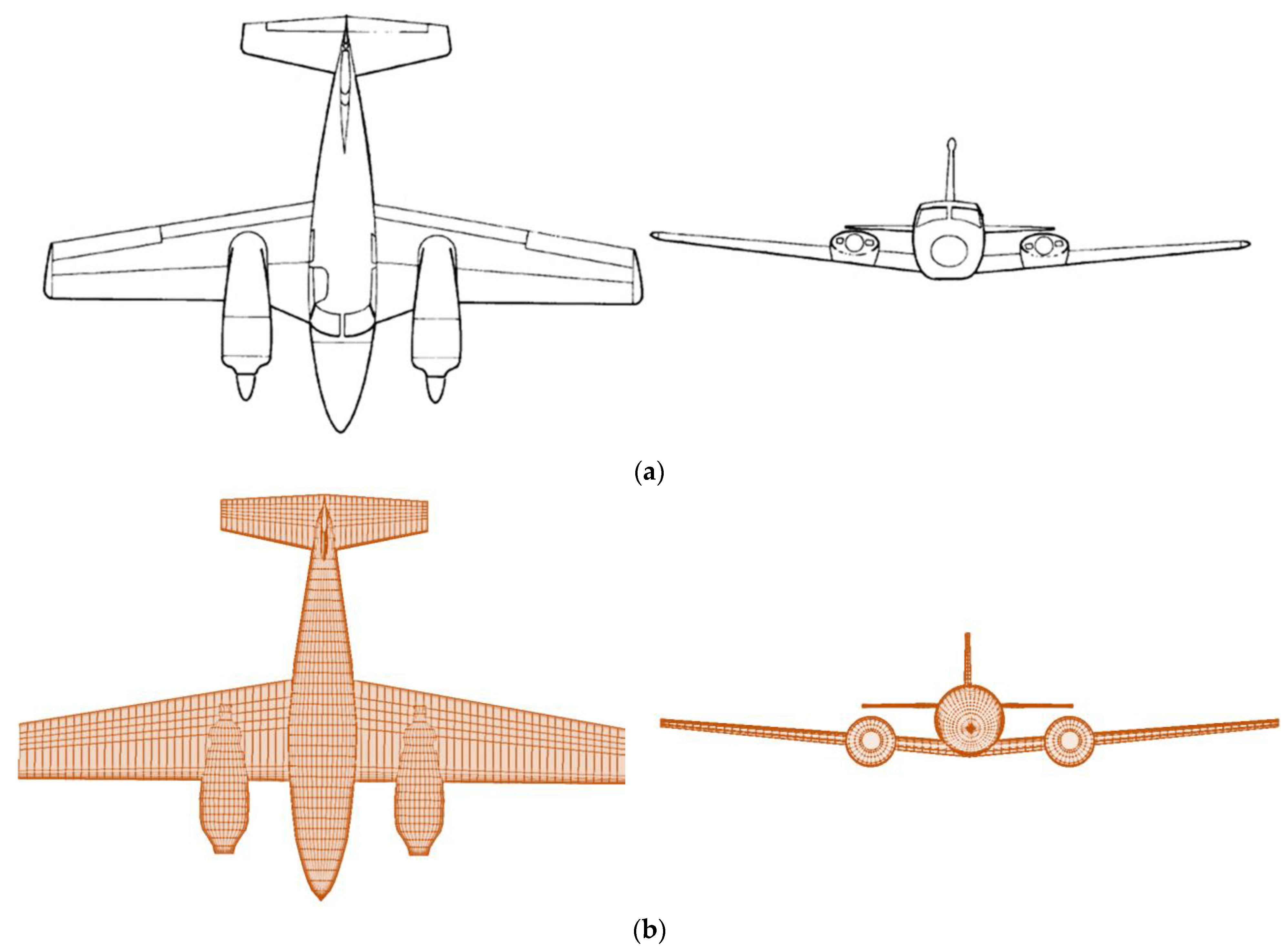
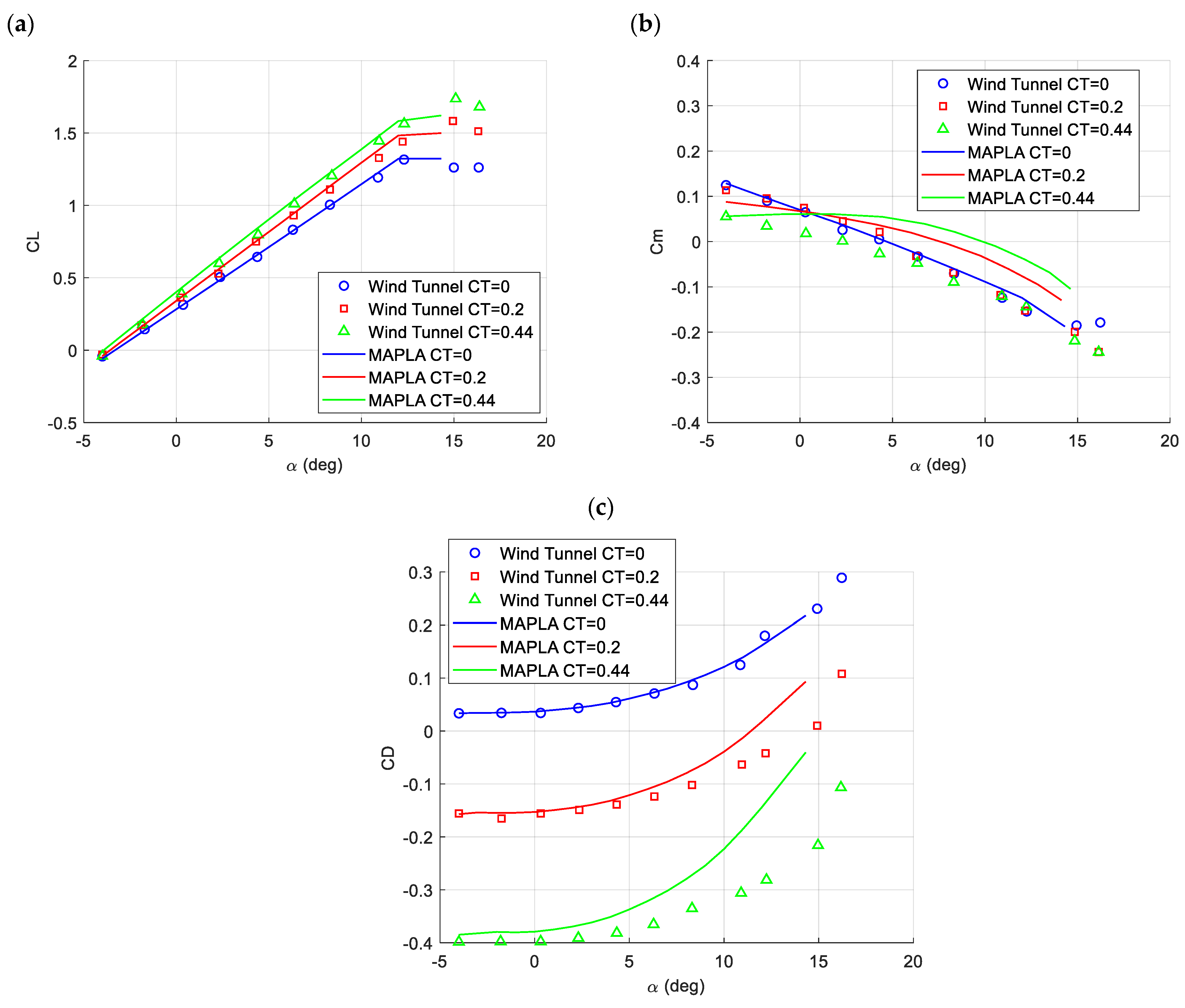
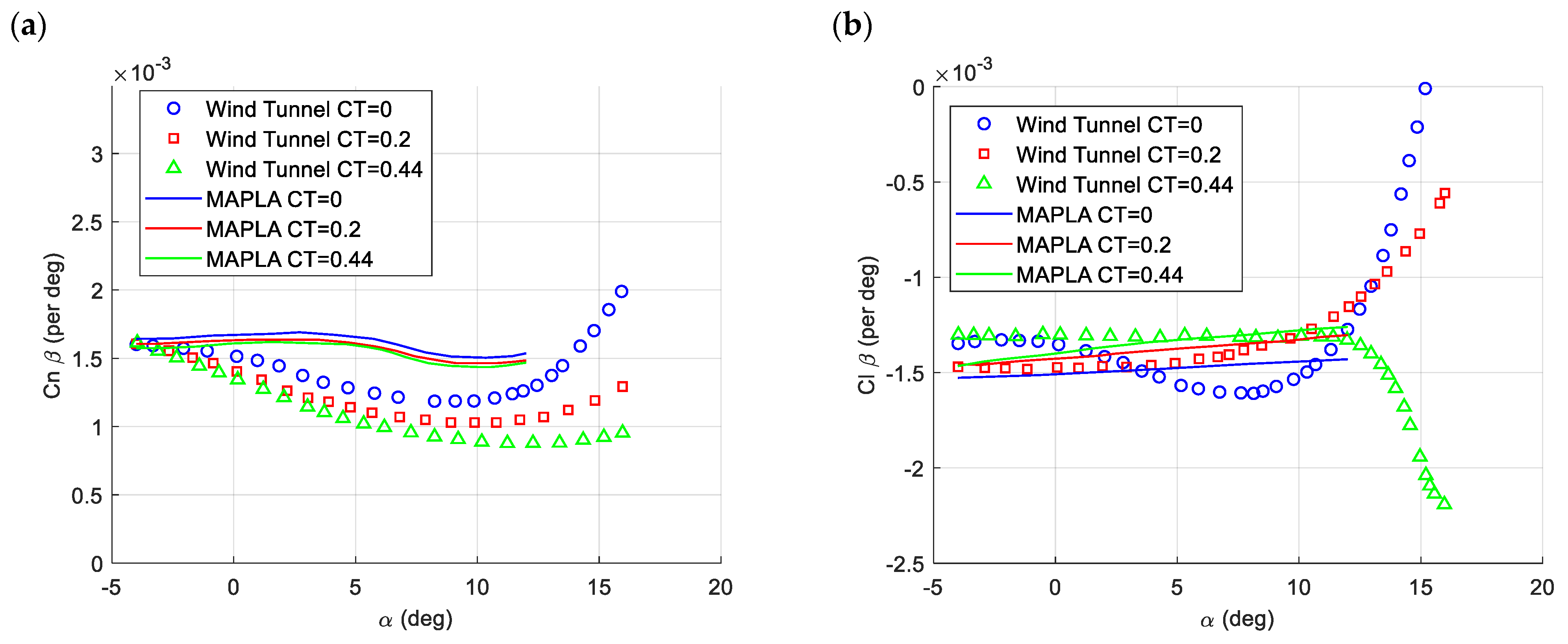
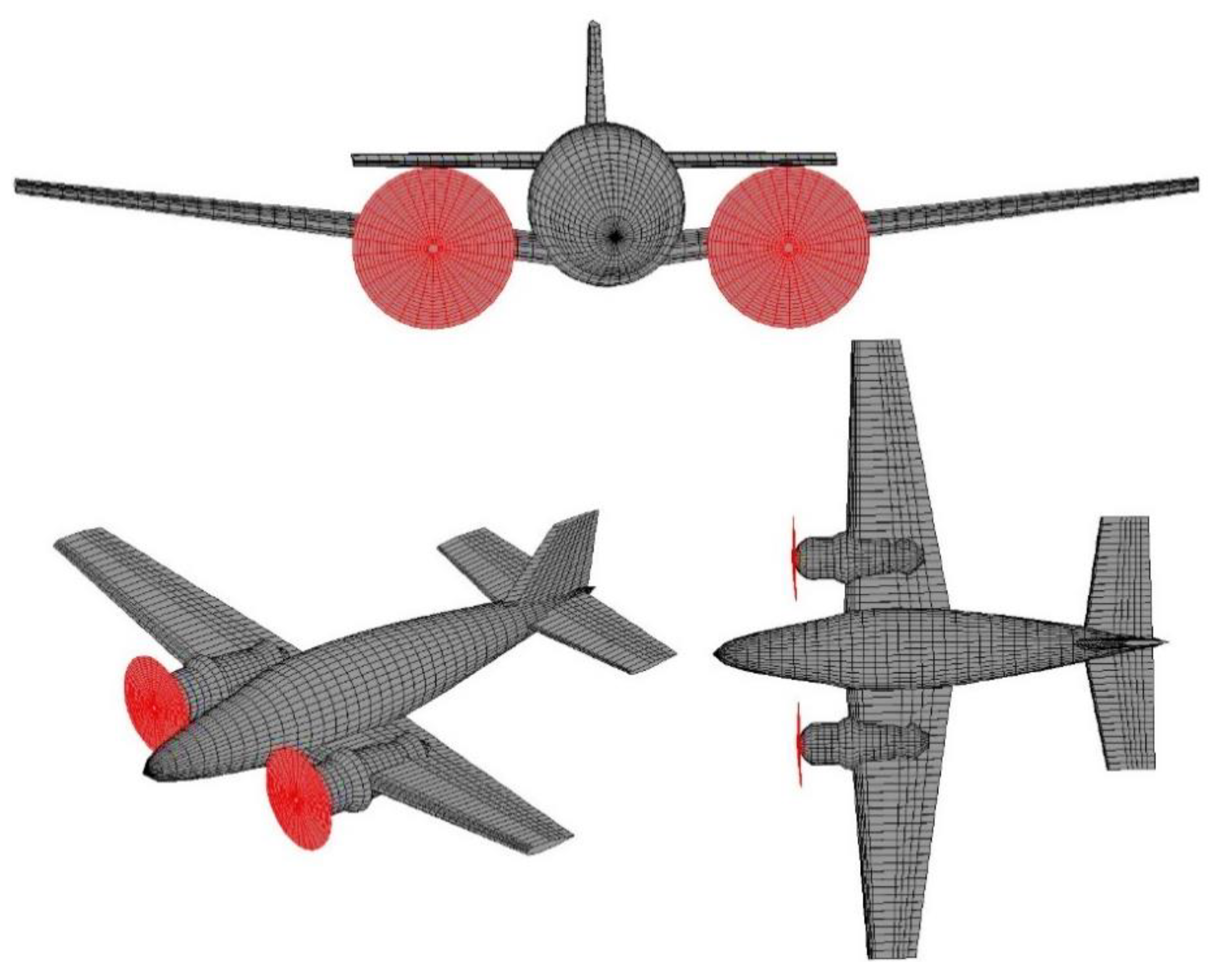
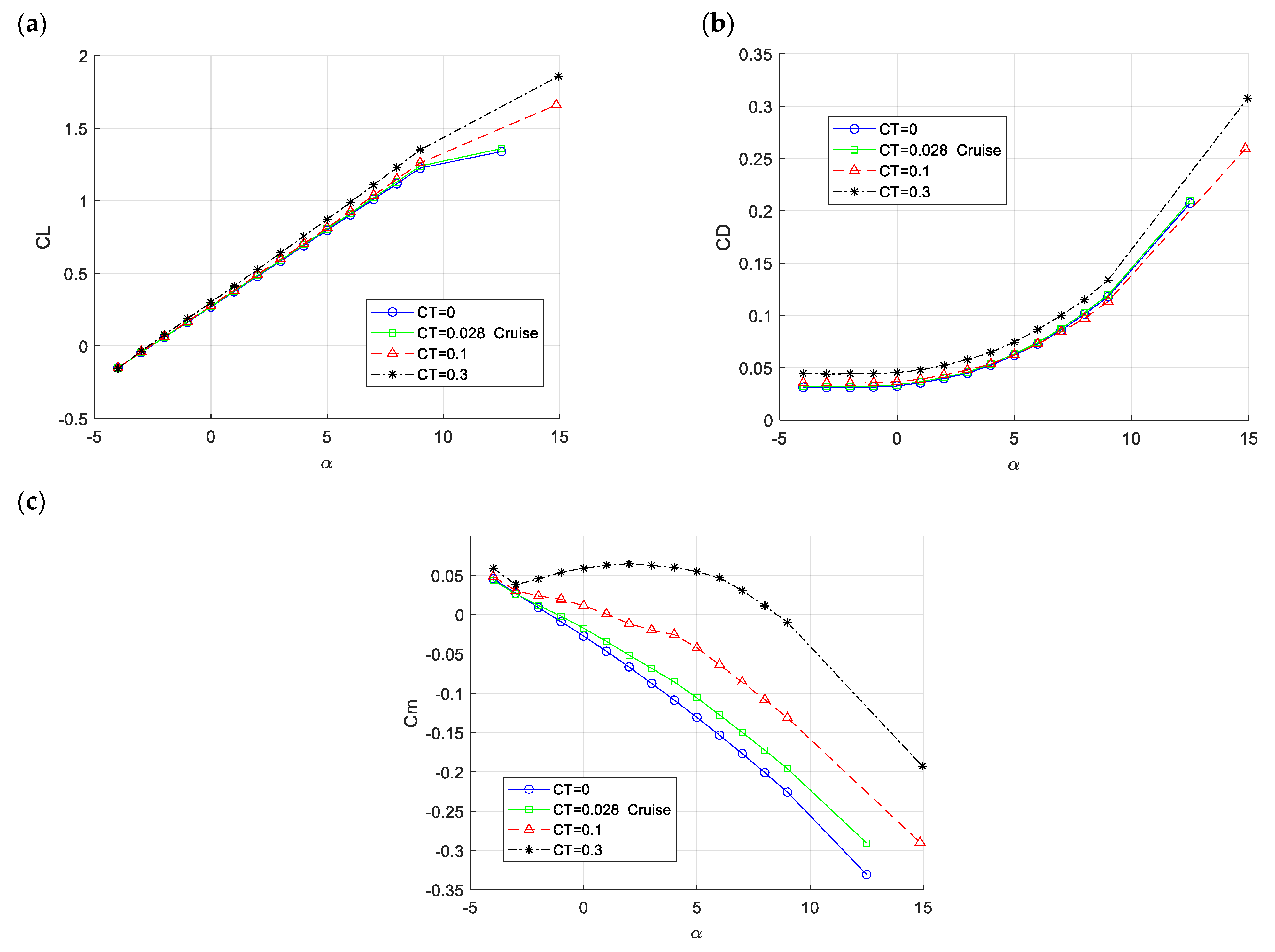

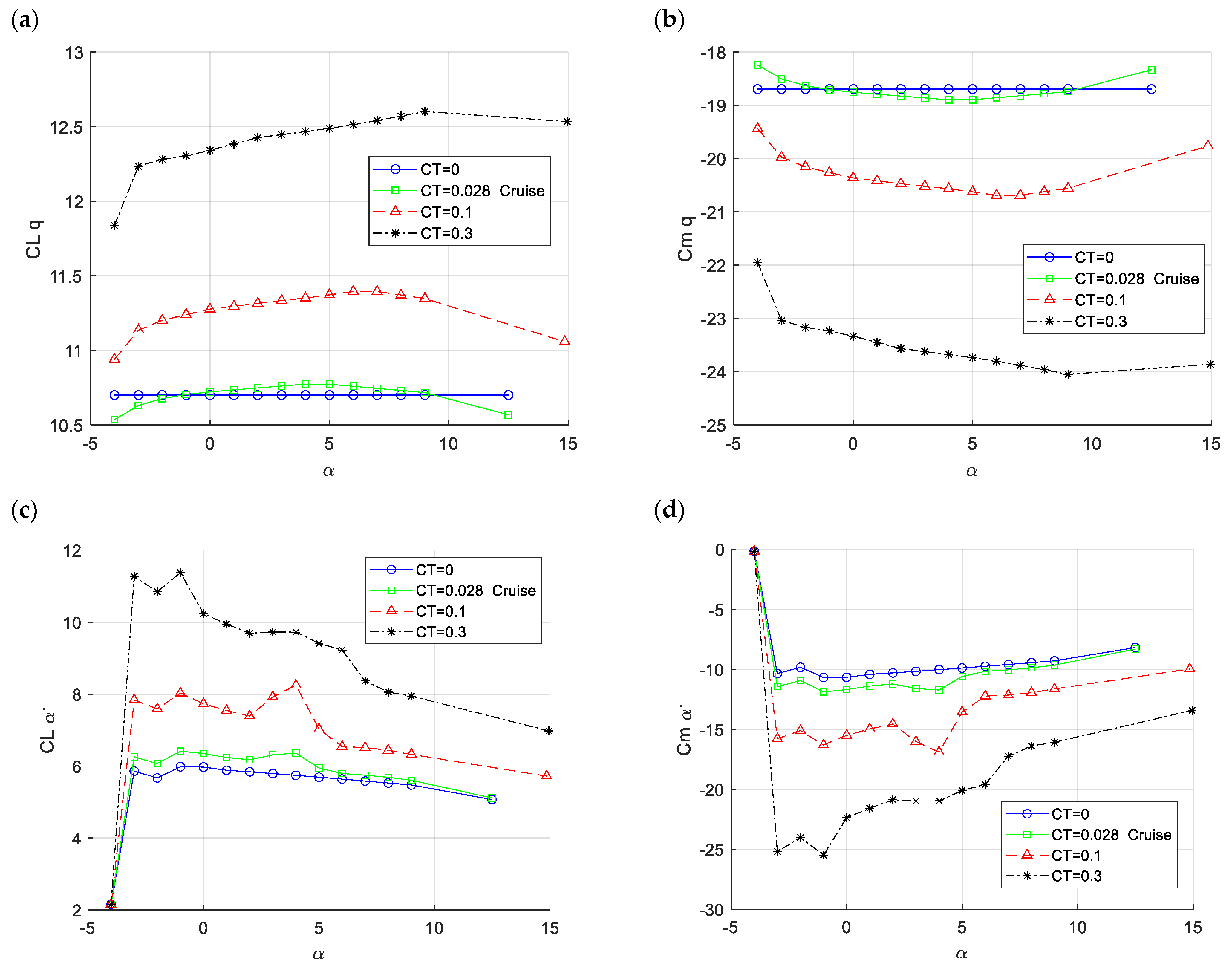
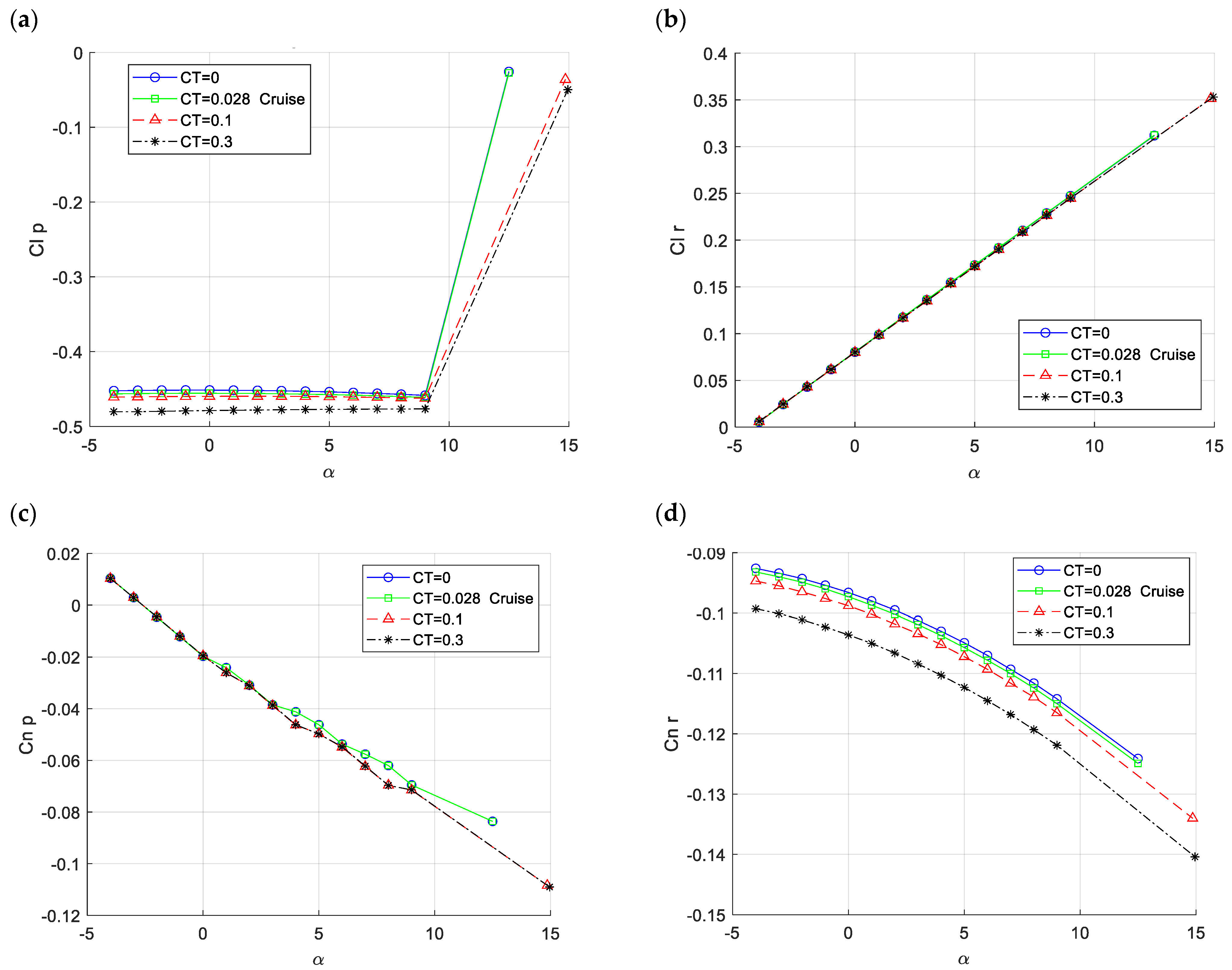
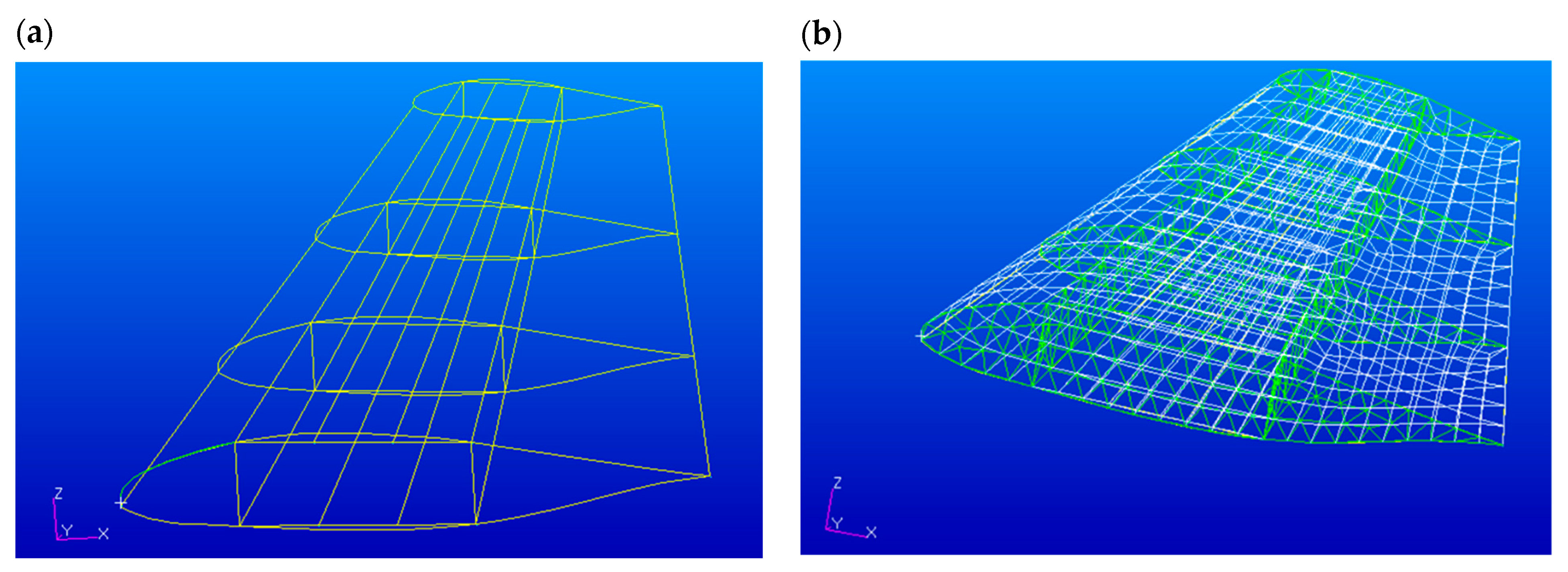
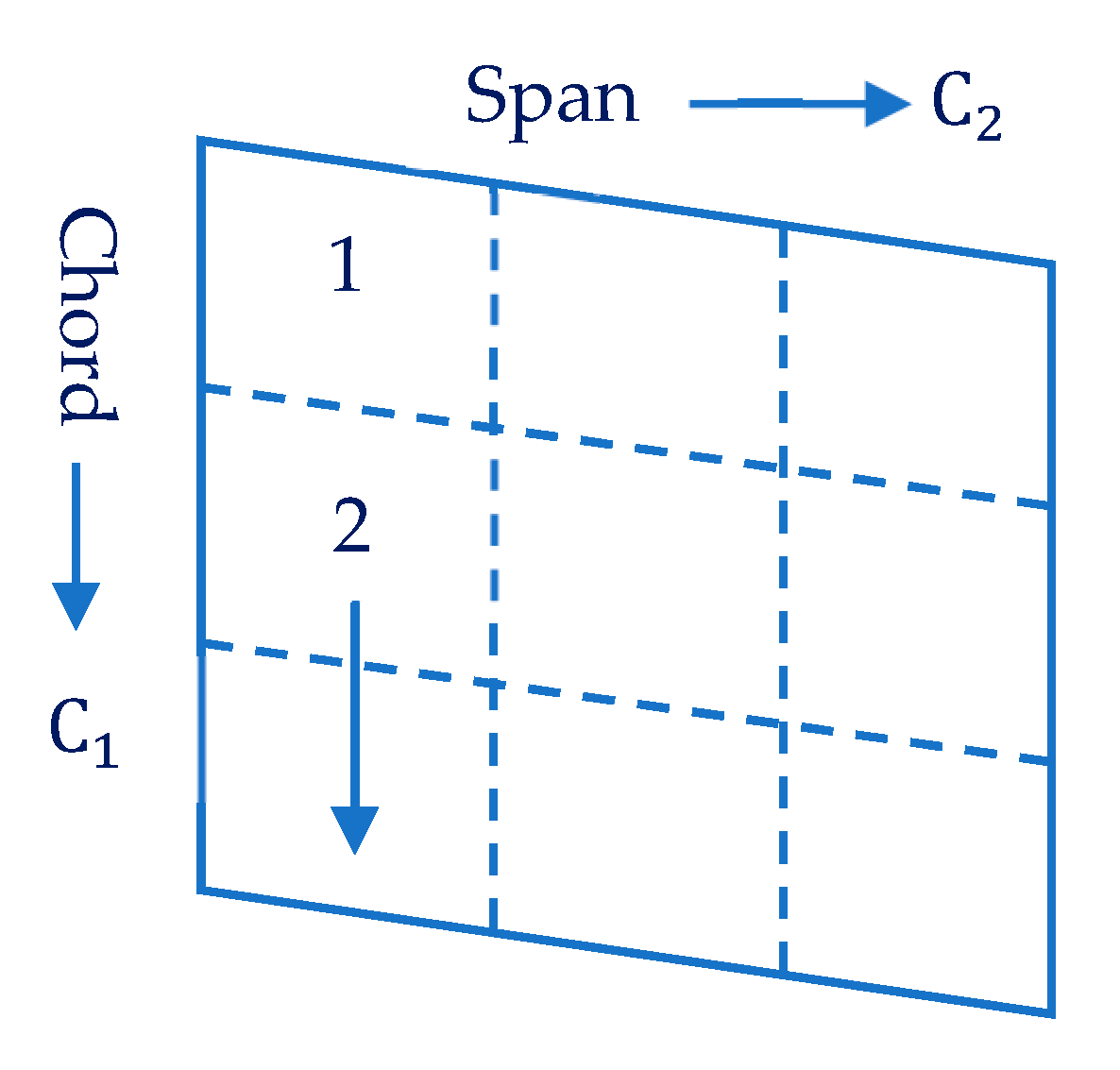
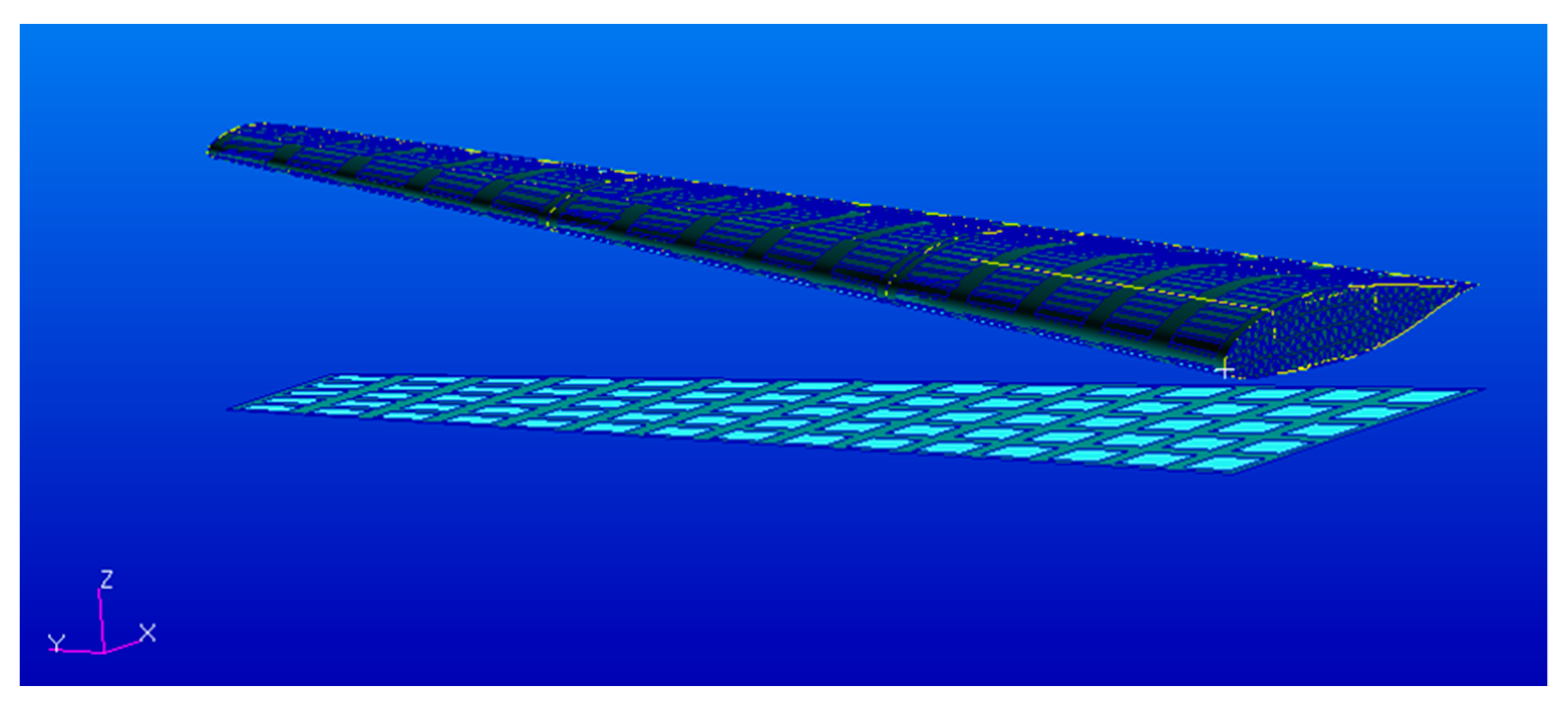



| Parameter | Description | Value |
|---|---|---|
| Wingspan, m | 10.97 | |
| MAC | Mean aerodynamic chord, m | 1.51 |
| Wing surface area, m2 | 16 | |
| AR | Aspect ratio | 7.52 |
| M | Mach number | 0.25 |
| Max take-off weight, Kg | 980 | |
| CG | Center of mass, % | 10 |
| h | Altitude, m | 0 |
| Aerodynamic Characteristics | Deviation from Wind Tunnel Tests (Linear Angles) | ||
|---|---|---|---|
| CT = 0 | CT = 0.2 | CT = 0.44 | |
| Component | Parameter | Description | Value |
|---|---|---|---|
| Fuselage | Fuselage length, m | 8.6 | |
| Planform area of fuselage, sq m | 8.0 | ||
| Maximum width of the fuselage, m | 1.545 | ||
| Horizontal Tail | Horizontal tail incidence angle, deg | 1.92 | |
| bh | Horizontal tail span, m | 4.95 | |
| Horizontal tail root chord, m | 1.29 | ||
| Horizontal tail tip chord, m | 0.82 | ||
| Leading edge sweep angle of the horizontal tail, deg | 12.2 | ||
| lh | Distance, parallel to the X-body axis, from the nose of the fuselage to the horizontal tail mean aerodynamic chord, m | 8.32 | |
| Vertical Tail | bv | Vertical tail span, m | 1.847 |
| Vertical tail root chord, m | 1.955 | ||
| Vertical tail tip chord, m | 0.874 | ||
| Trailing edge sweep angle of the vertical tail, deg | 17.15 | ||
| lv | Distance along the X-body axis from the nose of the fuselage to the leading edge of the tip chord of the vertical tail, m | 9.08 | |
| Wing | Wing incidence angle, deg | 2.74 | |
| Wing incidence angle | −3.15 | ||
| bw | Wing span, m | 11.95 | |
| Wing root chord, m | 2.143 | ||
| Wing tip chord, m | 0.9 | ||
| Wing leading edge sweep angle, deg | 3.2 | ||
| Wing trailing edge sweep angle, deg | −9.5 | ||
| lw | Distance, parallel to the X-body axis, from the nose of the fuselage to the leading edge of the wing mean aerodynamic chord, m | 2.76 | |
| Wing dihedral angle, deg | 7.5 | ||
| Engine and Propeller | Propeller efficiency, % | 80 | |
| Propeller blade angle at 0.75 Rp, deg | 20 | ||
| Number of blades | 3 | ||
| Width of propeller blade at 30%, m | 0.144 | ||
| Width of propeller blade at 60%, m | 0.16 | ||
| Width of propeller blade at 90%, m | 0.118 | ||
| Propeller radius, m | 0.993 | ||
| Maximum power per engine, hp | 300 | ||
| Number of engines | 2 | ||
| Weight and Balance | CG | Center of mass, % | 20 |
| Max take-off weight, Kg | 2500 |
| Surface | Element Shape | Mesh Style | Topology |
|---|---|---|---|
| Spars | Tria | Paver | Tria3 |
| Ribs | Tria | Paver | Tria3 |
| WB Skin | Quad | IsoMesh | Quad4 |
| Upper Wing Skin | Quad | IsoMesh | Quad4 |
| Lower Wing Skin | Quad | IsoMesh | Quad4 |
| Aerodynamic Characteristics | Rigid Airplane (MAPLA) | Elastic Airplane (MAPLA + NASTRAN) | Average Deviation | ||||||
|---|---|---|---|---|---|---|---|---|---|
| CT = 0 | CT = 0.028 | CT = 0.1 | CT = 0.3 | CT = 0 | CT = 0.028 | CT = 0.1 | CT = 0.3 | ||
| (rad−1) | 0.315 | 0.314 | 0.311 | 0.318 | 0.39 | 0.39 | 0.39 | 0.39 | 22.5% |
| (rad−1) | 6.05 | 6.11 | 6.19 | 6.57 | 6.98 | 7.04 | 7.13 | 7.58 | 15.3% |
| (rad−1) | 5.49 | 5.81 | 7.00 | 9.23 | 6.44 | 6.81 | 8.21 | 10.83 | 17.3% |
| (rad−1) | 10.70 | 10.71 | 11.28 | 12.37 | 12.42 | 12.43 | 13.09 | 14.36 | 16.0% |
| (rad−1) | −1.17 | −1.01 | −0.68 | −0.10 | −1.40 | −1.21 | −0.81 | −0.12 | 19.7% |
| (rad−1) | −9.32 | −10.20 | −13.47 | −19.61 | −11.4 | −12.43 | −16.41 | −23.89 | 21.8% |
| (rad−1) | −18.70 | −18.74 | −20.37 | −23.42 | −22.2 | −22.25 | −24.19 | −27.81 | 18.8% |
| (rad−1) | 0.12 | 0.12 | 0.12 | 0.12 | 0.13 | 0.13 | 0.13 | 0.13 | 4.2% |
| (rad−1) | −0.11 | −0.11 | −0.11 | −0.10 | −0.13 | −0.13 | −0.13 | −0.13 | 20.6% |
| (rad−1) | −0.45 | −0.46 | −0.46 | −0.48 | −0.59 | −0.60 | −0.60 | −0.62 | 30.4% |
Disclaimer/Publisher’s Note: The statements, opinions and data contained in all publications are solely those of the individual author(s) and contributor(s) and not of MDPI and/or the editor(s). MDPI and/or the editor(s) disclaim responsibility for any injury to people or property resulting from any ideas, methods, instructions or products referred to in the content. |
© 2024 by the author. Licensee MDPI, Basel, Switzerland. This article is an open access article distributed under the terms and conditions of the Creative Commons Attribution (CC BY) license (https://creativecommons.org/licenses/by/4.0/).
Share and Cite
Rostami, M. Propeller Effects and Elasticity in Aerodynamic Analysis of Small Propeller-Driven Aircraft and UAVs. Aerospace 2024, 11, 664. https://doi.org/10.3390/aerospace11080664
Rostami M. Propeller Effects and Elasticity in Aerodynamic Analysis of Small Propeller-Driven Aircraft and UAVs. Aerospace. 2024; 11(8):664. https://doi.org/10.3390/aerospace11080664
Chicago/Turabian StyleRostami, Mohsen. 2024. "Propeller Effects and Elasticity in Aerodynamic Analysis of Small Propeller-Driven Aircraft and UAVs" Aerospace 11, no. 8: 664. https://doi.org/10.3390/aerospace11080664






